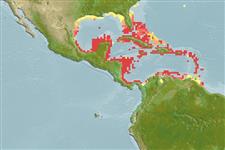>
Eupercaria/misc (Various families in series Eupercaria) >
Scaridae (Parrotfishes) > Scarinae
Etymology: Scarus: Greek, skaros = a fish described by anciente writers as a parrot fish; 1601 (Ref. 45335).
More on authors: Bloch & Schneider.
Environment: milieu / climate zone / depth range / distribution range
Ecología
marino asociado a arrecife; rango de profundidad 3 - 25 m (Ref. 9710). Tropical; 33°N - 8°N, 98°W - 59°W
Western Central Atlantic: Bermuda, Florida (USA), and Bahamas to northern South America; throughout the Caribbean Sea.
Tamaño / Peso / Age
Maturity: Lm ? range ? - ? cm
Max length : 61.0 cm TL macho / no sexado; (Ref. 7251); common length : 32.0 cm TL macho / no sexado; (Ref. 3802)
Espinas dorsales (total): 9; Radios blandos dorsales (total): 10; Espinas anales 3; Radios blandos anales: 9. Young adults of both sexes dark gray overall, with broad white stripe slightly below mid-side. Super males have upper pectoral fin margin and upper and lower margins of tail dusky with submarginal band of brownish orange (Ref. 26938).
Inhabits coral reefs and adjacent habitats. Feeds on algae scraped from rocks or dead coral. Sleeps in a mucus cocoon (Ref. 9710). Often seen in groups of one super male with several young adults, most of which are probably females (Ref. 26938). A protogynous hermaphrodite (Ref. 55367).
Life cycle and mating behavior
Madurez | Reproducción | Puesta | Huevos | Fecundidad | Larva
Forms permanent harem groups composed of a single male and several smaller females (Ref. 55367). A monandric species (Ref. 55367). Length at sex change = 25.2 cm TL (Ref. 55367).
Robins, C.R. and G.C. Ray, 1986. A field guide to Atlantic coast fishes of North America. Houghton Mifflin Company, Boston, U.S.A. 354 p. (Ref. 7251)
IUCN Red List Status (Ref. 130435)
Threat to humans
Reports of ciguatera poisoning (Ref. 30911)
Human uses
Pesquerías: escaso valor comercial; Acuario: Comercial
Más información
ReferenciasAcuiculturaPerfil de acuiculturaRazasGenéticaElectrophoresesheritabilidadEnfermedadesProcesamientoNutrientsMass conversion
Herramientas
Special reports
Download XML
Fuentes de Internet
Estimates based on models
Preferred temperature (Ref.
123201): 26.2 - 28.2, mean 27.4 °C (based on 528 cells).
Phylogenetic diversity index (Ref.
82804): PD
50 = 0.5000 [Uniqueness, from 0.5 = low to 2.0 = high].
Bayesian length-weight: a=0.01445 (0.00686 - 0.03044), b=3.03 (2.86 - 3.20), in cm total length, based on LWR estimates for this Genus-body shape (Ref.
93245).
Nivel trófico (Ref.
69278): 2.0 ±0.00 se; based on food items.
Generation time: 1.8 ( na - na) years. Estimated as median ln(3)/K based on 1
growth studies.
Resiliencia (Ref.
120179): Alto, población duplicada en un tiempo mínimo inferior a 15 meses (K=0.6).
Fishing Vulnerability (Ref.
59153): Low to moderate vulnerability (28 of 100).
Nutrients (Ref.
124155): Calcium = 34.6 [22.3, 60.2] mg/100g; Iron = 0.758 [0.526, 1.144] mg/100g; Protein = 18.8 [16.7, 20.6] %; Omega3 = 0.0836 [, ] g/100g; Selenium = 21.8 [13.9, 34.1] μg/100g; VitaminA = 32.1 [9.6, 110.6] μg/100g; Zinc = 1.95 [1.48, 2.53] mg/100g (wet weight);
